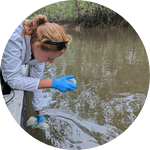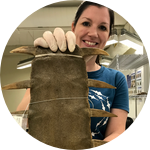About This Project
The Critically Endangered Largetooth Sawfish is one of the most threatened of all marine fishes. They have historically been, and still are, exploited for their toothy saw. After global declines, Brazil is likely the last place this species is found in the Atlantic.This project aims to use DNA from old saws to assess Largetooth Sawfish genetic health in Brazil which is a critical step to giving this species a fighting chance against extinction.
Ask the Scientists
Join The DiscussionWhat is the context of this research?
Largetooth Sawfish in Brazil are vital to the survival of this species because outside of the Indo-West Pacific, Brazil is thought to have the largest, and likely the only, remaining population in the Atlantic of this once circumtropical ray. To effectively develop management plans for this species in Brazil we first need to understand their genetic health. Our knowledge of the genetic health of Largetooth Sawfish in Brazil is limited because they are so difficult to find and sample from in the wild. We are currently using the DNA from old saws found in museums to assess the genetic health of Largetooth Sawfish globally but had few samples from Brazil until one of our team members was able to gather over 100 old saws in Brazil for us to use.
What is the significance of this project?
The IUCN Shark Specialist Group recognizes Brazil as a “Beacon of Hope” population for Largetooth Sawfish and the first step to effectively managing this population is to understand their genetic health. The Largetooth Sawfish specimens our team member has in Brazil provide our only opportunity to gather their genetic data because this species is too rare to collect DNA from wild individuals. Analyzing the DNA from these specimens will immediately tell us how much genetic diversity is found in Largetooth Sawfish in Brazil and how genetically unique Brazil is compared to populations left in the Indo-West Pacific. Our earlier research has suggested that Brazil may be the last population of a genetically distinct Atlantic/Eastern Pacific clade of Largetooth Sawfish.
What are the goals of the project?
This project aims to analyze the genetic health of Largetooth Sawfish in Brazil by looking at their genetic diversity. The higher the genetic diversity the more equipped a population is to adapt to changes in their environment and withstand disease. We will use Largetooth Sawfish saws that were historically taken from sawfish in Brazil and kept as trophies. Our team member and colleagues were able to find over 100 saws in museum collections, people’s homes, etc. We will extract DNA from these saws using techniques we developed for saws and then amplify the DNA.We need funding for the final step in this process which is to determine the DNA sequence to analyze how much genetic diversity is found in the Brazil population.
Budget
These funds are helping to fill a gap in a project looking at the genetic health of global populations of Largetooth Sawfish. We previously received funding to develop and use mtDNA and microsatellite loci to analyze ~150 samples we have in our lab. Out of the samples in our lab, we do not have many from Brazil so we currently have a gap in our data. The reason we need additional funds is because we received a scholarship to travel to Brazil and utilize over 100 samples that have been collected there by one of our team members and cannot be shipped to our lab in the US. Travel and living expenses are covered for the trip to Brazil and we have funding to extract the samples but we are lacking the funding for the final step of analyzing the DNA. This last part of the project is essential to assessing the genetic health of Largetooth Sawfish in Brazil.
Endorsed by
 Project Timeline
Project Timeline
This project will be done within a 9-month period. We will be leaving for Brazil in March of 2024 and returning in November 2024. Our first month in Brazil will be used to collect tissue samples from the Largetooth Sawfish saws available to us. The second month will be used to attempt DNA extraction on all the tissue samples and see which ones yield DNA. In the following months, we will amplify and then sequence/genotype the DNA to analyze the genetic health of the population.
May 05, 2023
Project Launched
Mar 15, 2024
Travel to Brazil
Apr 15, 2024
Complete sampling from all Largetooth Sawfish saws
May 15, 2024
Complete DNA extraction from all samples
Aug 15, 2024
Complete PCR amplification of DNA
Meet the Team
Affiliates
Team Bio
My Ph.D. advisor, Dr. Nicole Phillips is an expert in sawfish conservation genetics and her expertise in this subject will help guide this project to success. Dr. Patricia Charvet is a Brazilian sawfish researcher and is providing expertise on sawfish in Brazil and the samples that will be used in this research. Dr. Vanessa Cruz is a geneticist in Brazil that will help with successfully generating the genetic data.
Annmarie Fearing
I have been working in the sawfish field for about 8 years and it all started when I was an undergraduate student volunteering for the Florida Museum of Natural History. The museum basement that I volunteered in was full of these amazingly odd sawfish saws and I thought these animals were the strangest things I had ever seen. Years later my graduate work revolves around finding these saws in museum basements, people’s homes, etc. to assess the genetic health of Largetooth Sawfish. I have completed a master's with Dr. Nicole Phillips assessing Largetooth Sawfish genetic health and I am pursuing my Ph.D. to expand on this work.
I am passionate about using museum specimens to help conserve biodiversity on Earth and spreading this message to the public. So many amazing specimens are available to the scientific community to answer our questions about species and our use of sawfish saws demonstrates this. Outreach is a great way to show how useful museum specimens can be to science and it gives the public a chance to see what goes on behind the exhibits at a museum. Many people do not realize there are millions of specimens found below their feet in museum basements and I would love to help remedy this. Sawfish saws provide the perfect specimens to wow and entice the public and I hope to continue this outreach with sawfish during my trip to Brazil!
Nicole Phillips
I am an Associate Professor at the University of Southern Mississippi and the Vice President of the Sawfish Conservation Society. My research is focused on using molecular tools to support conservation of threatened species. I am particularly interested in imperiled rays, and have been studying sawfish conservation genetics for nearly 20 years.
Patricia Charvet
I have been studying sawfish in South America since 1998 and over these years received lots of sawfish parts donations from Brazilian fishers by asking them to provide samples that would help towards improving their management and conservation. The study in collaboration with Jens Hegg (microchemistry), Annmarie, Nicole and Vanessa (genetics) will certainly be extremely valuable to better understand biology, habitat use, and population structure of sawfish, therefore contributing to their conservation in Brazil.
Project Backers
- 8Backers
- 104%Funded
- $5,735Total Donations
- $716.88Average Donation




